
Central Methodist University is a private university in Fayette, Missouri. CMU is accredited to offer masters, bachelors, and associate degrees. The school is affiliated with the United Methodist Church.

QEBH is a senior honor society at the University of Missouri. Founded in 1898, it is the oldest of six recognized secret honor societies that participate in the annual tradition of Tap Day on campus.

University, Hayes and Orton Halls are three historic buildings on the Oval at the Ohio State University in Columbus, Ohio. On July 16, 1970, they were added to the National Register of Historic Places. The original University Hall was demolished in 1971, and removed from the National Register that year.

Connecticut Hall is a Georgian building on the Old Campus of Yale University. Completed in 1752, it was originally a student dormitory, a function it retained for 200 years. Part of the first floor became home to the Yale College Dean's Office after 1905, and the full building was converted to departmental offices in the mid-twentieth century. It is currently used by the Department of Philosophy, and its third story contains a room for meetings of the Yale Faculty of Arts & Sciences, the academic faculty of Yale College and the Graduate School.

Sanborn Seminary is a historic educational facility in Kingston, New Hampshire. Its main building was built in 1883 by Major Edward S. Sanborn to serve as a secular secondary boarding school. The school ran continuously until 1966 when it was sold to the Town of Kingston. The campus became known as Sanborn Regional High School and served students from the towns of Kingston, Newton, and Fremont. The last class at this campus graduated in June 2006.

Jesse Hall, formerly New Academic Hall, is the main administration building for the University of Missouri. Its dome has towered 180 feet (55 m) above the south end of David R. Francis Quadrangle since its completion in 1895. In the lawn in front of Jesse Hall are The Columns, all that remains of its predecessor Academic Hall, which was destroyed by fire in 1892. The building contains the office of the chancellor, university registrar, graduate school, admissions, and financial aid. One of the most photographic landmarks in Missouri, the building was designed by Missouri architect Morris Frederick Bell, and is his largest surviving work. Jesse Auditorium had hosted graduations and many university functions over the years. The University Concert Series presents national and international concerts, Broadway shows, performers, bands, speakers, and theater to the largest auditorium in Columbia. As the former home of the School of Music, student performances occasionally take place. The building is the most prominent contributing structure to the David R. Francis Quadrangle National Register of Historic Places District. In 1922, "New Academic Hall" was renamed "Jesse Hall" in honor of retiring University President Richard Henry Jesse.
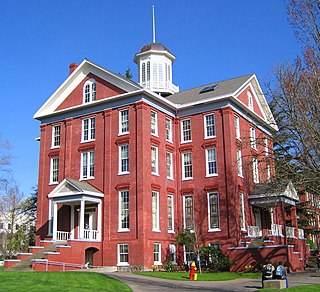
Waller Hall is a building on the campus of Willamette University in Salem, Oregon, in the United States. Opened in 1867 as University Hall, it is the oldest higher-education building west of the Mississippi River still in use, currently housing the university's administrative offices.

David R. Francis Quadrangle is the historical center of the University of Missouri in Columbia, Missouri. Known as The Quad, it is the oldest part of Red Campus and adjacent to Downtown Columbia at the south end of the Avenue of the Columns. At its center are six Ionic columns, all that remains of the original university building Academic Hall. Twelve buildings front the modern quadrangle including the domed main administration building Jesse Hall, the tallest building in Columbia. The Quad was designed and constructed by architect Morris Frederick Bell and his assistant William Lincoln Garver. It is named after Missouri governor David R. Francis. Eighteen structures, including the entire quad and most of Red Campus are listed as the Francis Quadrangle National Historic District. An obelisk, the original tombstone of Thomas Jefferson, stands in front of the Chancellor's Residence. It was gifted to the University by Jefferson's descendants in recognition of Missouri's ties to Virginia. In front of Jesse Hall stand markers honoring university president Richard Henry Jesse and Missouri governor David R. Francis. Nearby is another obelisk in memory of Missouri's first U.S. senator David Barton, The Missouri School of Journalism is located at the northeast corner of The Quad, comprising Walter Williams Hall, Neff Hall, Gannet Hall, along with the Reynolds Journalism Institute. To the west, Switzler Hall is the oldest academic building on campus, though the Residence on the Quad, home of the chancellor, is the oldest building overall. The University of Missouri College of Engineering completes the west side. Pickard Hall is currently closed due to radiation contamination from turn of the century experiments. Swallow Hall was recently renovated and houses the Departments of Anthropology, Visual Studies and Ancient Mediterranean Studies.

Wesleyan Hall, constructed in 1856, is one of the oldest structures on the University of North Alabama campus, located in Florence, Alabama.
Red Campus is the historical core of the University of Missouri campus in Columbia primarily gathered around the David R. Francis Quadrangle. The area takes its name from the red bricks that make up most of the buildings including Jesse Hall and Switzler Hall. The campus contains 18 buildings on the National Register of Historic Places and area is nearly congruent with the Francis Quadrangle National Historic District. The Red Campus stands in contrast to the neo-gothic White Campus, which it borders on the east.
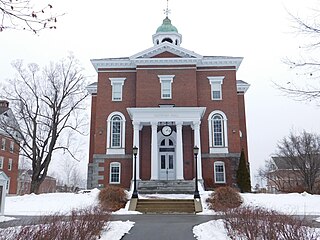
Hathorn Hall is a historic academic building on the campus of Bates College in Lewiston, Maine. Built in 1857 to a design by Gridley J.F. Bryant, it was the college's first academic building following the move of the Maine State Seminary from Parsonsfield to Lewiston. The building was listed on the National Register of Historic Places in 1970.

Academic Hall was the original main building of the University of Missouri. It was dedicated in 1843 and destroyed by fire in 1892. Academic Hall's six Ionic columns, today known as The Columns, stand on Francis Quadrangle as the most recognizable symbol of the University of Missouri.

Manasseh Cutler Hall is the oldest academic building at Ohio University and the oldest in the original Northwest Territory of the United States. It is located at the center of the Ohio University campus in Athens, Ohio. A National Historic Landmark, it continues to house school offices. It was named for Manasseh Cutler, a New England physician, botanist, and minister who wrote the University's charter in 1804.
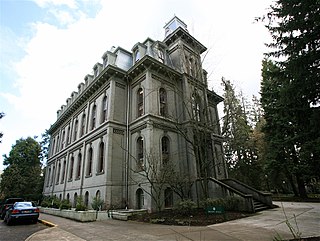
University and Villard Halls, University of Oregon are historic academic buildings on the campus the University of Oregon in Eugene, Oregon. Built in 1876 and 1886 respectively, they are among the oldest surviving academic buildings on the west coast of the United States, and are noted for their Second Empire architecture. They were designated a National Historic Landmarks as a pair in 1977.

The University of Missouri is a public land-grant research university in Columbia, Missouri. It is Missouri's largest university and the flagship of the four-campus University of Missouri System. MU was founded in 1839 and was the first public university west of the Mississippi River. It has been a member of the Association of American Universities since 1908 and is classified among "R1: Doctoral Universities – Very high research activity".
The University of Arkansas Campus Historic District is a historic district that was listed on the National Register of Historic Places on September 23, 2009. The district covers the historic core of the University of Arkansas campus, including 25 buildings.
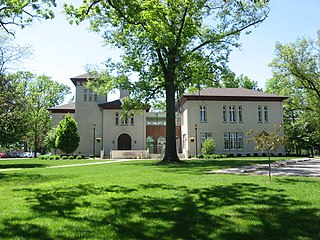
The Urbana College Historic Buildings are a historic district on the campus of Urbana University in Urbana, Ohio, United States. Composed of three nineteenth-century buildings, the district includes the oldest structures on the university's campus.

The Drake University Campus Historic District is located in Des Moines, Iowa, United States. The historic district contains six buildings. Five of the buildings are collegiate buildings on the Drake University campus and one is a church. The period of significance is from when the university was founded in 1881 to the end of the presidency of Hill M. Bell in 1918. The historic district has been listed on the National Register of Historic Places since 1988. It is part of the Drake University and Related Properties in Des Moines, Iowa, 1881—1918 MPS.
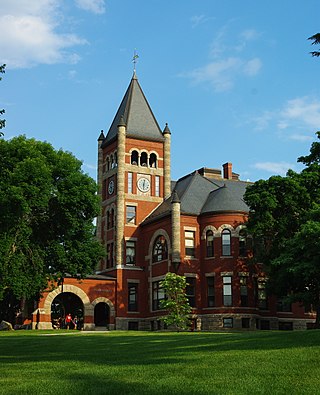
Thompson Hall, commonly referred to locally as "T-Hall", is one of the central buildings on the campus of the University of New Hampshire in Durham, New Hampshire, United States. A large brick and stone building, it was designed by Concord architects Dow & Randlett and built in 1892. It was the first building to be built on the Durham campus, and was named for Benjamin Thompson, a farmer who left his entire Durham estate to the state for use as the college campus. The building was listed on the National Register of Historic Places in 1996.

The Columns are the most recognizable landmark of the University of Missouri in Columbia, Missouri. Standing 43 feet (13 m) tall in the center of Francis Quadrangle and at the south end of the Avenue of the Columns, they are the remains of the portico of Academic Hall. Along with Jesse Hall, they are one of the most photographed sites in Missouri. The Columns have been at the center of many traditions and events including graduations, concerts, pranks, weddings, and protests. Mizzou's school song mentions the columns, and they have been the setting for a work of fiction. They are a contributing structure to the Francis Quadrangle National Historic District. The columns underwent preservation work in 2017.



















